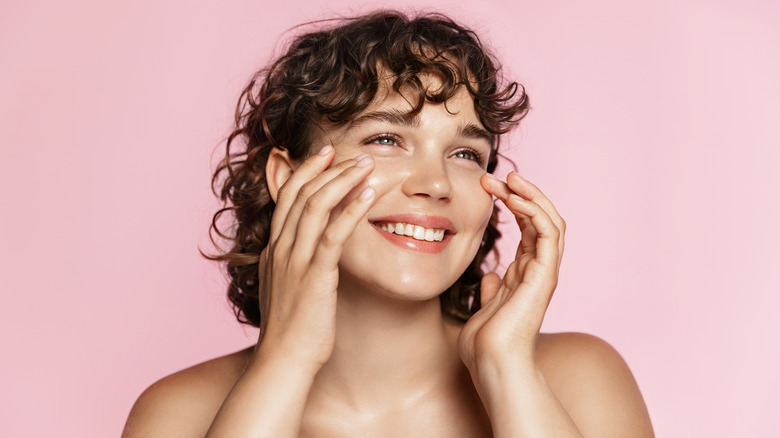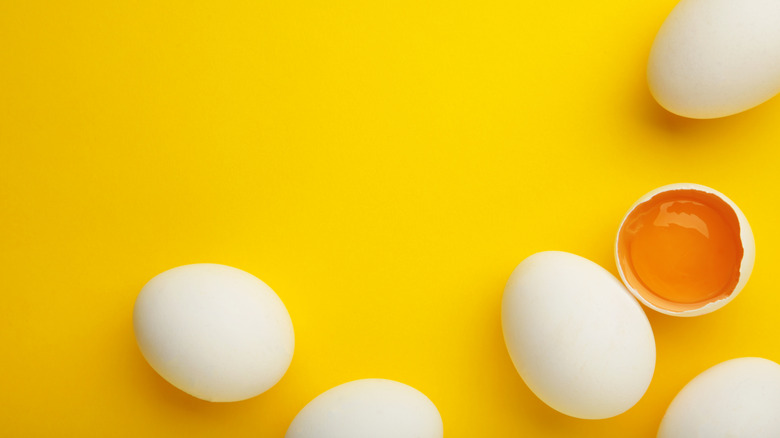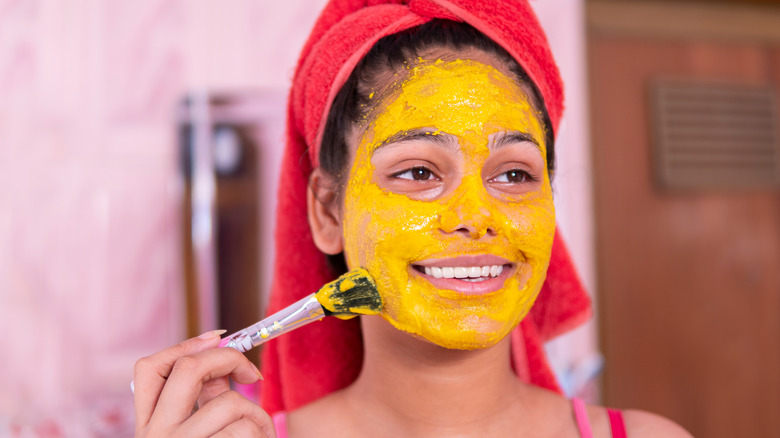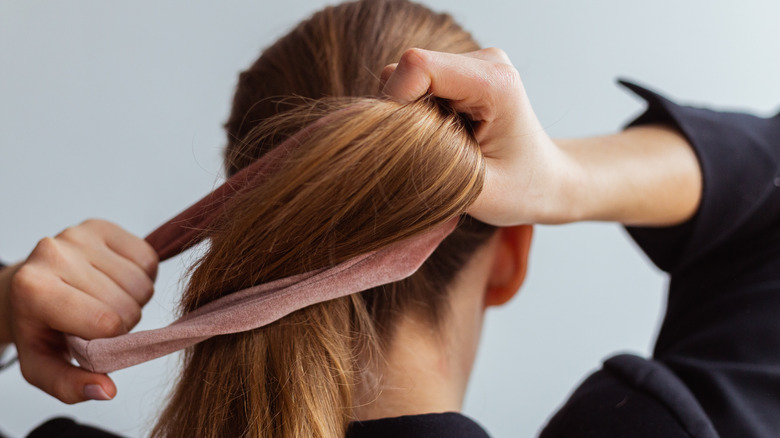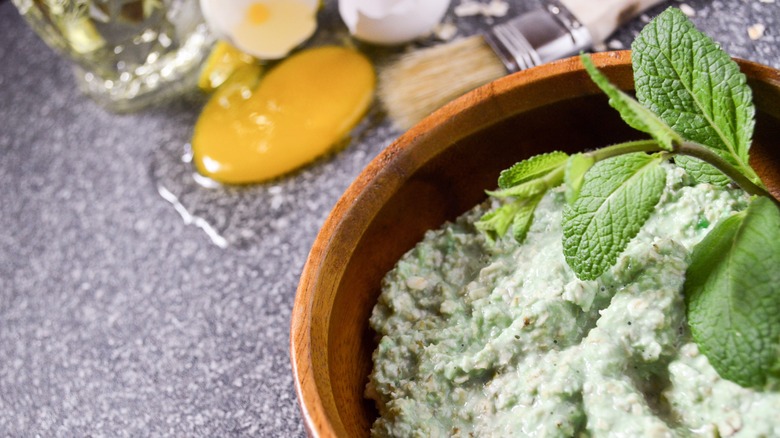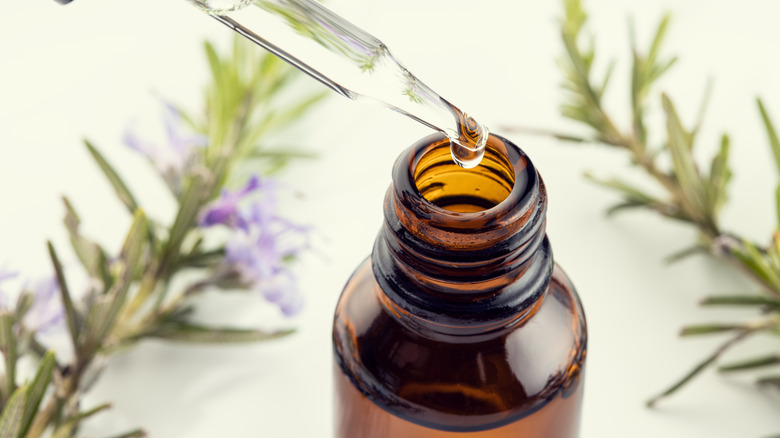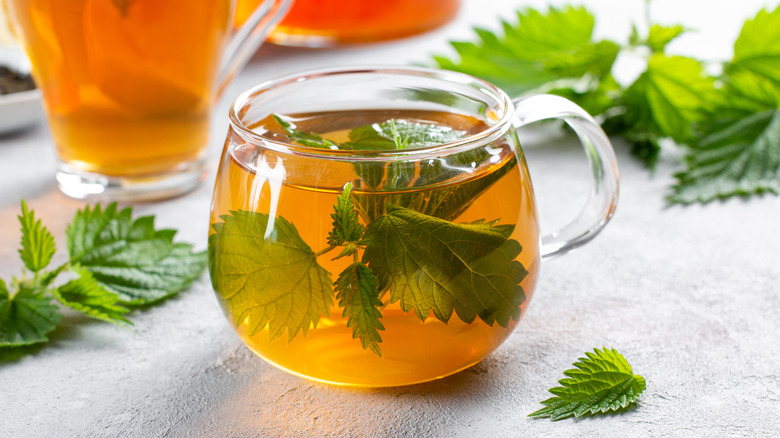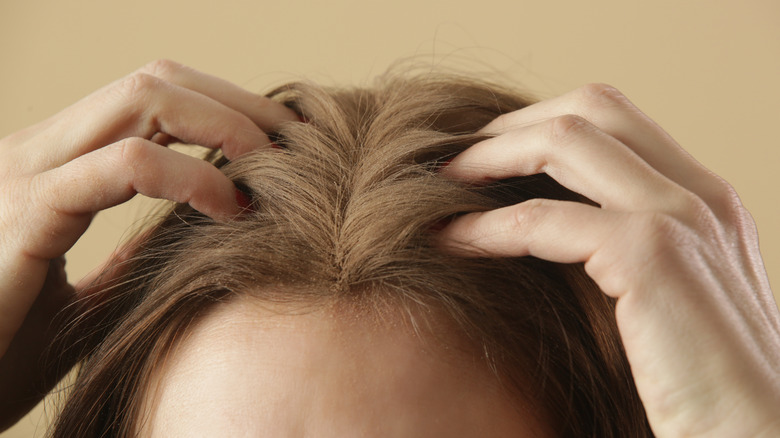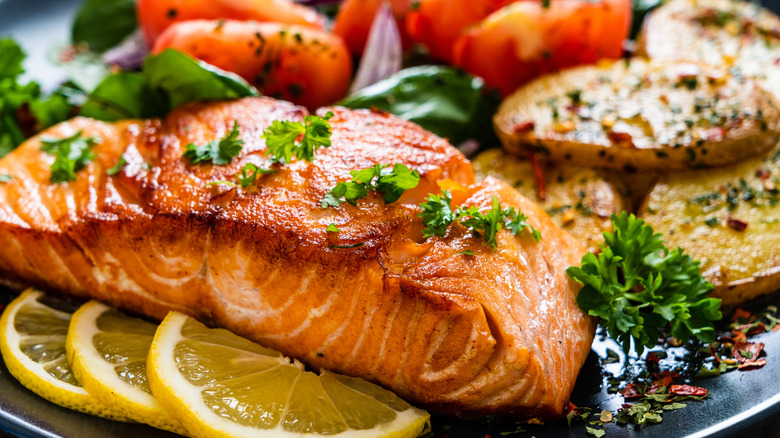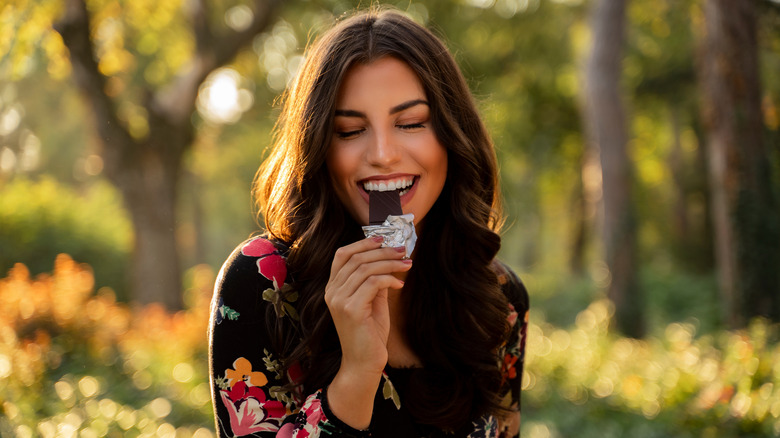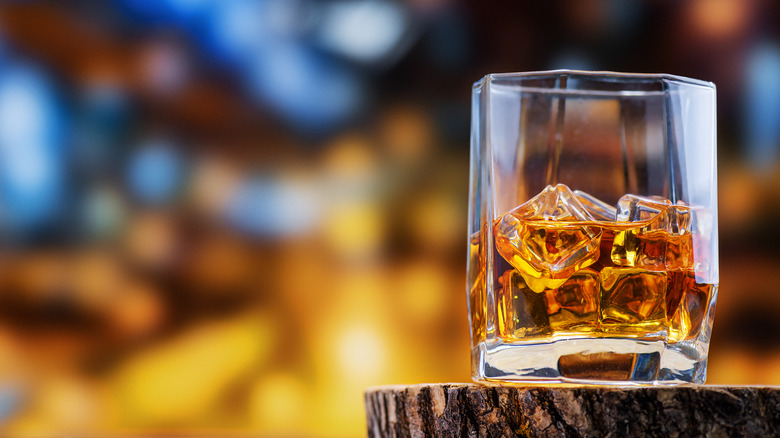Unexpected Ways To Help Your Skin And Hair
Having gorgeous skin and beautiful hair are two things that most people strive to have. And they will happily fork over their hard-earned money on dubious or expensive products that promise to help them achieve their beauty goals. According to Harvard Medical School, Americans spend more than $5 billion annually on anti-aging products in addition to money spent on invasive cosmetic procedures. Women are particularly susceptible to this cost. A 2017 Groupon for Merchants survey found the average woman spends $3,756 per year on beauty treatments and services, compared with around $2,928 per year for men.
No one wants to experience frizzy hair with lots of breakages, increased hair fall, weak nails, or dry, dull skin. These beauty pitfalls can have a drastic impact on our mood and self-confidence. However, no one wants to go broke buying products that don't work either. Luckily, there are many unexpected ways to help your skin and hair that won't cost you an arm and a leg, from eating certain foods to crafting DIY hair and face masks using ingredients you have lying around your kitchen.
Make a hair mask out of egg yolk
Raw eggs may not be an ideal addition to your daily diet due to the threat of salmonella. However, this protein-packed superfood is liquid gold for your hair. According to Hello Glow, egg yolks contain folate, biotin, and vitamins A and E, all of which are necessary for strong, healthy, and glossy hair. Applying an egg yolk hair mask regularly can also help reduce hair fall.
Plain egg yolk masks can smell a little, well, eggy. Although it is perfectly fine to apply only egg yolks directly to the scalp or hair shafts, you may want to consider adding a few drops of lavender, rosemary, or rosehip essential oil as well to make the smell more pleasant. Hair-friendly oils like coconut oil, while not particularly aromatic, are also great additions to the egg yolk for growing out your hair.
Raw eggs also have nourishing properties that benefit the skin. Egg whites in particular contain a simple protein called albumin, which acts as an astringent when applied to the skin. This astringent effect temporarily constricts the skin for a smoothing effect. According to the Minnesota School of Cosmetology, applying a DIY egg white mask to your face and allowing it to harden helps tighten and firm fine lines and wrinkles in the skin. It also minimizes the look of large pores and can help clear blackheads resulting from oily skin.
Apply a turmeric mask to your face and hair
Although today it is commonly enjoyed in curries, soups, cocktails, and lattes, turmeric can help alleviate a variety of skin and hair woes. According to Kew Royal Botanic Gardens, the golden-colored root spice has been used worldwide for more than 2,000 years for beauty and medicinal purposes. It has been found to contain anti-fungal, anti-bacterial, and anti-inflammatory properties, while also believed to aid in digestion and counteract signs of aging. Plus, it's delicious!
Trichologist William Gaunitz, W.T.S., shared with Byrdie that the anti-inflammatory properties of turmeric are commonly found in hair products to treat dandruff, control oil, and improve hair growth. "Most hair loss is caused at least on some level due to inflammation," he explained. "Reducing inflammation, in turn, reduces the impact of pattern hair loss or directly inflammatory hair loss on the scalp and hair follicles."
Turmeric is also beneficial for treating a variety of skin conditions. According to Greatist, its powerful antioxidants and anti-inflammatory properties work together to fade acne scars, soothe plaque psoriasis symptoms, and combat sun damage. It can also provide a warm, glowing effect after only a few weeks of use. Some people apply turmeric to the skin to treat stretch marks. Turmeric can be consumed in food or beverages, but applying a few drops of turmeric essential oil to your favorite cleanser or lotion is a great way to see faster results for your skin.
Quit using hair ties
If you want to improve the strength and quality of your hair, as well as eliminate excess shedding, quit using basic hair ties. Many people like the convenience of the cotton-encased rubber bands, which can be found at almost every pharmacy or drugstore. However, pulling back your hair with these ties, particularly in tight buns or ponytails, damages the hair follicles and results in the fraying of the hair shaft.
When worn tightly on the wrist, hair ties can cause a temporary indentation due to physical constriction. This isn't inherently dangerous, this physical constriction can lead to more severe injuries. Huma Sheikh, a neurologist at NY Neurology Medicine, told HuffPost, "There are many arteries and nerves that travel around the wrist area. It is possible that depending on how tight a hairband is, it can push or compress on the arteries, tendons, and nerves that are in that area." Long-term tingling, numbness, and physical pain in the wrist, fingers, and hands may be symptoms of nerve damage.
Styling your hair doesn't mean an endless barrage of braids and headbands. Claw clips are an excellent alternative to hair elastics, adding function and style without causing hair fallout or putting strain on the scalp. Hair ties made of silk or satin will help reduce breakage while coiled hair ties provide a gentle hold without leaving a dent. Scrunchies, scarves, and ribbons are also great alternatives to a traditional hair tie, so, needless to say, your options are endless, and you can undoubtedly find one that matches your aesthetic and needs.
Improve your acne with mint
There is nothing worse than frequent, unmanageable breakouts. Whether your acne is a result of your diet and exercise routine or an unpleasant addition to your period, some evidence suggests that cool, refreshing mint may be the answer.
HowStuffWorks explains that mint has high concentrations of vitamin A and salicylic acid, an active ingredient in most acne products. This combination helps loosen up the dirt and dead skin cells in your pores that can cause pimples if left to their own devices while also controlling oil production. Mint possesses astringent properties as well, making it a useful tool for tightening the appearance of facial skin. Furthermore, mint is an antipruritic agent that relieves dry, itchy, or inflamed skin. The high levels of antioxidants present in mint can also help inhibit harmful free radicals and reduce oxidative stress (via PubMed Central).
Many skincare products contain mint, both for its soothing smell and its acne-fighting properties. However, you can easily make a natural mint face mask at home. Using a mortar and pestle, grind up a handful of fresh mint leaves and add a few drops of water to make a paste. Apply the paste to your face, focusing on the areas where you are breaking out. When the mask has dried, remove it with lukewarm water. You can also add a teaspoon of organic honey, which has its own antimicrobial properties for added acne-fighting power, to the paste.
Apply rosemary essential oil to your hair
Aromatic, fresh, and earthy rosemary tastes great, but it also has seemingly magical properties for your hair when made into an oil. Rosemary, which is a part of the mint family, possesses similar anti-inflammatory and antibacterial properties. When regularly applied to the scalp, rosemary essential oil can speed up cell turnover leading to thicker, healthy-looking hair (via MarthaStewart.com). It also contains antioxidants that protect your hair from free radicals caused by the sun and other environmental stressors.
Marnie Nussbaum, M.D., F.A.A.D., explained the hair growth benefits of rosemary oil to Elle. "The rosemary plant contains carnosic acid, which is known to heal nerve damage, tissue damage, and improve cellular turnover. Therefore, it encourages nerve growth and improves blood circulation... without a proper blood supply, the follicles do not get the nutrients they need to grow the hair, and they can die off."
Rosemary oil is easy to make at home. Simply add a few drops of rosemary essential oil to a carrier oil like coconut, argan, or jojoba oil and mix to combine. Alternatively, you can add a few drops to your shampoo bottle. Although working rosemary oil into the ends of your hair certainly won't hurt, the oil works best when applied and massaged into the scalp. Start out with the oil treatment once or twice a week before working up to a daily application.
Enjoy stinging nettle tea
Stinging nettle is a popular medicinal herb that has been used for thousands of years to treat a variety of ailments. According to Mount Sinai, stinging nettle was traditionally used in Medieval Europe as a cure for joint pain and a diuretic. It was used by Ancient Egyptians to manage back pain and by Romans as a skin-warming lotion (via Healthline). Today, it is used to lower blood sugar and blood pressure, as well as treat urinary tract infections, osteoarthritis, certain allergies, hypoglycemia, and hay fever. This potent herb is also used by herbalists to treat hair and scalp issues.
Anti-inflammatory and astringent properties within stinging nettle can reduce dandruff, decrease oily hair, and provide some needed moisture to dry, damaged locks. It contains a number of nutrients and minerals vital for hair health, as well as the ability to reduce inflammation of the scalp and hair follicles and block internal end external DHT, an androgen hormone responsible for hair loss and male pattern baldness (via Hairguard).
Nettle can be enjoyed as a supplement or infused into oils for direct application to the scalp. It can also be drunk in tea. According to MDhair, infuse 4 to 6 teaspoons of dried nettle in 4 cups of hot water, and let it steep for 20 minutes before drinking. It has a bright, earthy taste similar to green tea. There is also little to no bitterness.
Don't shampoo every day
In recent years, hair care experts and influencers alike have touted the benefits of ditching your daily shampoo. Many people wash their hair on a daily basis primarily to avoid greasy-looking hair. However, the frequency with which you wash your hair is a significant contributor to an oily scalp. Trichologist Kate Holden told Mane Addicts, "Washing your hair too often can cause your scalp to overproduce sebum. Not washing your hair enough will cause buildup. Washing your hair two or three times per week is recommended to get a good balance."
While the exact number of days per week you should shampoo ultimately depends on your hair's individual needs, daily shampooing is universally hard on your hair. Washing it seven days a week can lead to dry skin and dandruff, irritation, inflammation of the hair follicles, and extra oiliness. Instead, consider a daily rinse to remove sweat, dirt, and hair product.
Dry shampoo is another great alternative for keeping your hair looking fresh and volumized between washes. Dry shampoo absorbs oil and sweat without removing it entirely from the scalp. The Good Trade recommends organic, eco-friendly, and cruelty-free dry shampoos that don't use aerosol, chemicals, or alcohol, which can dry and dull your hair. It is also important not to overuse dry shampoo, as too much can lead to a buildup that clogs the hair follicles. Generally, one to two days of use per week is plenty to get you over the hump of non-washing days.
Eat plenty of omega-3s
Omega-3s are fatty acids commonly found in fish, plants, and seeds that are incredibly important for maintaining a healthy body (via the Cleveland Clinic). They are often promoted for heart health and strong bones, but they also have amazing benefits for the skin.
Omega-3s play an important role in the structural integrity, functionality, and appearance of the skin. According to Live Science, omega-3s are also believed to improve skin hydration, reduce premature aging, and balance oil production that leads to acne. They have been proven to help reduce the effects of UV-induced photodamage and inflammatory skin responses like sunburns as well (via Oregon State University). In addition to giving you soft, smooth skin, omega-3s are also helpful for combating skin conditions such as eczema or psoriasis. A diet lacking sufficient omega-3s may result in itchy, swollen, or rough skin, although this specific deficiency is rare.
Despite its importance, omega-3s are not produced in adequate amounts by the body, which is why eating a diet rich in this essential nutrient is necessary. Omega-3-rich foods include chia seeds, walnuts, salmon, mackerel, and tuna, as well as plant oils like flaxseed or canola (via the National Institutes of Health). In the event that adding these foods to your diet is not sufficient for your needs, you may want to look into taking omega-3 supplements. According to Healthline, omega-3 supplements containing FFA (free fatty acids), triglycerides, and PLs (phospholipids), as well as a sufficient amount of EPA and DHA, are ideal.
Eat skin-healthy foods
Diet is essential for obtaining glowing skin that never needs a photo filter. In addition to fatty fish and nuts, a diet rich in fruits and vegetables provides the skin with all of the vitamins and minerals it needs to stay healthy and beautiful. Foods with high water content and plenty of antioxidants like watermelon, berries, tomatoes, and bell peppers are ideal for protecting the skin from damage. Additionally, foods packed with Vitamin C like grapefruit and oranges have been found to have anti-aging effects (via research published in the American Journal of Clinical Nutrition).
Dark chocolate has a variety of health and skin benefits as well. According to Hudson Valley Functional Medicine, some studies suggest that the cocoa bioactive compounds found in high-quality dark chocolate are helpful for maintaining skin health as we age. The presence of flavonoids also gives dark chocolate antioxidative, anti-inflammatory, anti-carcinogenic, and anti-mutagenic properties (via PubMed).
There are also a number of foods to enjoy in moderation or scrap entirely. Caffeinated coffee, for example, is known to increase the body's stress response leading to overactive sebaceous glands and acne. Green tea is a lower-caffeine alternative to promote skin health. Cosmetic dermatologist Kaleroy Papantoniou, M.D., told Eat This, Not That!, "Since green tea contains polyphenols, making it an antioxidant and anti-inflammatory, it can be used as a great toner to treat acne. It's great for healing blemishes and scars, flushes out toxins, and also keeps skin supple. The vitamin K in green tea helps lighten dark circles under the eyes, too."
Enjoy whiskey for healthy skin and hair
When it comes to healthy skin and hair, few people think of whiskey as the solution to their troubles, but whiskey can help your skin and hair in unexpected ways. Although enjoying whiskey for its intended purpose, i.e. drinking, probably won't help your skin, applying it externally can have some amazing benefits. For starters, whiskey's alcohol content and antioxidant properties make it an excellent alternative to traditional astringents like witch hazel, vinegar, or rubbing alcohol. It is also considerably less dehydrating. Seriously Natural recommends combining whiskey and water in a bowl and using a cotton ball to dab it all over your face. Once your face dries, wash with lukewarm water and a gentle cleanser.
Whiskey can also be used to promote hair growth. When combined with a beaten egg and applied to the hair shafts, whiskey acts as a great pre-conditioning treatment, and can even help stimulate growth by reducing inflammation of the hair follicles and removing the buildup of dirt and oil.
At-home whiskey facial masks are great for soaking up excess oil and tightening the appearance of pores. The best whiskey pore-tightening mask requires egg whites, powdered milk, and whiskey. In a small bowl, gently beat the egg whites until a light foam appears. Add 2 teaspoons of whiskey and 1 tablespoon of powdered milk to form a paste. Apply the mask to your face and let it dry, rinse with cool water, and pat dry to finish.
